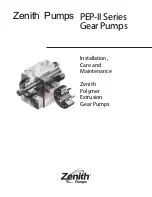
10
O
BSTRUCTIONS
, F
AN
C
LEARANCE
AND
W
IRING
Remove any extraneous construction and shipping materials that
may be found during this procedure. Rotate all fans manually to
check for proper clearances and that they rotate freely. Check for
bolts and screws that may have jarred loose during shipment to
the job site. Retighten if necessary. Re-tighten all electrical con-
nections.
F
IELD
D
UCT
C
ONNECTIONS
Verify that all duct connections are tight and that there is no air
bypass between supply and return.
F
ILTER
S
ECTION
C
HECK
Remove filter section access panels and check that filters are prop-
erly installed. Note airflow arrows on filter frames.
P
RE
-
STARTUP
P
RECAUTIONS
It is important to your safety that the unit has been properly
grounded during installation. Check ground lug connection in main
control box for tightness prior to closing circuit breaker or discon-
nect switch. Verify that supply voltage on line side of disconnect
agrees with voltage on unit identification plate and is within the
utilization voltage range as indicated in Appendix B Electrical Data.
System Voltage -
That nominal voltage value assigned to a circuit
or system for the purpose of designating its voltage class.
Nameplate Voltage -
That voltage assigned to a piece of equip-
ment for the purpose of designating its voltage class and for the
purpose of defining the minimum and maximum voltage at which
the equipment will operate.
Utilization Voltage -
The voltage of the line terminals of the equip-
ment at which the equipment must give fully satisfactory perfor-
mance. Once it is established that supply voltage will be main-
tained within the utilization range under all system conditions,
check and calculate if an unbalanced condition exists between
phases. Calculate percent voltage unbalance as follows:
Three Phase Models Only
3) PERCENT VOLTAGE
UNBALANCE
2) MAXIMUM VOLTAGE DEVIATIONS
FROM AVERAGE VOLTAGE
1) AVERAGE VOLTAGE
HOW TO USE THE FORMULA:
EXAMPLE: With voltage of 220, 216, and 213
1) Average Voltage = 220+216+213=649 / 3 = 216
2) Maximum Voltage Deviations from Average Voltage = 220 - 216 = 4
3) Percent Voltage Unbalance = 100 x
=
= 1.8%
Percent voltage unbalance MUST NOT exceed 2%
.
4
216
400
216
= 100 X
AIR FLOW ADJUSTMENTS
NOTE:
For 2 speed models, airflow adjustments must be made on
high speed, i.e., 2nd stage cooling or in heat mode.
The drive on the supply fan is typically set in the middle of the
RPM range. The drive motor sheave pitch diameter is field adjust-
able for the required airflow. Refer to “Drive Adjustments” section
below.
When the final adjustments are complete, the current draw of the
motor should be checked and compared to the full load current
rating of the motor. The amperage must not exceed the service
factor stamped on the motor nameplate. The total airflow must
not be less than that required for operation of the electric heaters
or the furnace.
If an economizer is installed, check the unit operating balance with
the economizer at full outside air and at minimum outside air. Upon
completion of the air flow balancing, we recommend replacing
the variable pitched motor sheave with a properly-sized fixed
sheave. A matching fixed sheave will provide longer belt and bear-
ing life and vibration free operation. Initially, it is best to have a
variable pitched motor sheave for the purpose of airflow balanc-
ing, but once the balance has been achieved, fixed sheaves main-
tain alignment and minimize vibration more effectively. For direct
drive units, move green wire for fan.
NOTE:
Never run CFM below 350 CFM per ton, evaporator freezing
or poor unit performance is possible.
PSC M
OTOR
Adjust the CFM for the unit by changing the speed tap of the in-
door blower motor at the EBTDR “com” connection with the one
of the speed taps on “M1” or “M2” (Black-High Speed, Blue-Me-
dium Speed, Red-Low Speed).
EEM M
OTOR
Adjust the CFM for the unit by changing the position of the low
voltage leads on the motor terminal block. Green is for Fan Only.
Yellow is for Cooling and Heat Pump Heating. Refer to Appendix A
for blower performance at each speed tap.
NOTE:
If more than
one lead is energized simultaneously, the motor will run at the
higher speed.
E
VAPORATOR
F
AN
R
OTATION
C
HECK
(T
HREE
P
HASE
M
ODELS
O
NLY
)
Check that fan rotates counter-clockwise when viewed from the
drive side of unit and in
accordance with rotation arrow shown on
blower housing. If it does not, reverse the two incoming power
cables. In this case, repeat bearing check.
Do not attempt to change load side wiring. Internal wiring assures
all motors and compressors will rotate in correct direction once
evaporator fan motor rotation check has been made.
E
LECTRICAL
I
NPUT
C
HECK
Make preliminary check of evaporator fan ampere draw and verify
that motor nameplate amps are not exceeded. A final check of
amp draw should be made upon completion of air balancing of
the duct system (see Appendix B).
BELT DRIVE MODELS ONLY
The drive on the supply fan is typically set in the middle of the
RPM range. The drive motor sheave pitch diameter is field adjust-
able for the required airflow. Refer to “Motor Sheave Adjustmens”
section.
Upon completion of the air flow balancing, we recommend re-
placing the variable pitched motor sheave with a properly-sized
fixed sheave. A matching fixed sheave will provide longer belt and
bearing life and vibration free operation. Initially, it is best to have
a variable pitched motor sheave for the purpose of airflow balanc-











































